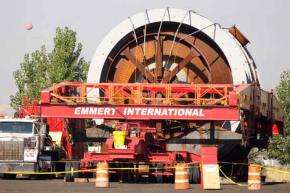Protesting the “Heavy Haul”
reports on a struggle against environmental devastation and for the rights of Native American tribes that spans the states of the Pacific Northwest.
MORE THAN two dozen activists and members of local Native American communities gathered March 20 at the confluence of the Columbia and Willamette Rivers in Portland, Ore., to protest the use of the Columbia to ship large pieces of equipment toward a new Alberta tar sands refinery currently under construction.
The demonstration was organized by Indigenous People for Sustainable Lifestyles, based in Eugene, Ore., and was timed to coincide with a walk/march at the Heart of the Monster--birthplace of the Nez Perce tribe--in Kamiah, Idaho.
It was the first time a protest against the shipping route occurred in Portland. Groups like Rising Tide and All Against the Haul supported the demonstration and helped to publicize it, but the tone of the gathering was set by Indigenous People for Sustainable Lifestyles.
Communities across the Northwest U.S. and Canada have been rightfully alarmed about the impact of both the tar sand refineries and the hauling of massive equipment to the site of the facilities.

The current equipment shipment has been dubbed the Kearl Module Transport Project, and is known as the "Heavy Haul." The final location for the equipment is the new Kearl Oil Sands project 40 miles north of Fort McMurry in Alberta, Canada.
THE HEAVY Haul route starts where the Columbia River meets the Pacific Ocean in Oregon and travels up the Columbia and Snake Rivers through northern Oregon and southwest Washington. At Port Lewiston in Idaho, equipment is transferred from barges to trucks with trailers that take up two lanes of traffic and have up to 14 axles. The trucks continue along Route 12--a winding, sometimes mountainous and steep road--through Idaho and Montana, until they reach Canada and eventually the refinery sites.
The trucks are so large because they transport South Korean-made Kearl modules. Each module weighs in at 650,000 pounds and is 30 feet high, 30 feet wide and over 220 feet long. That's heavier than the Statue of Liberty, as tall and wide as a three-story building and three-quarters of a football field in length.
Since Highway 12 is only two lanes wide and wasn't built to withstand such heavy loads, the economic ecological impacts of hauling this equipment are immense.
Texas, which has recently seen an increase in mega-load traffic, is a case study of the economic effects. According to reporter Kate Galbraith of the Texas Tribune, "[T]rucking companies and the industries they serve rarely shoulder the cost of fixing the damage [to roads caused by mega-load traffic], which can run in the hundreds of thousands of dollars for a single state road."
In 2007, the Texas Department of Transportation spent $23 million on repairs in Johnson County alone--taxpayer money going to fix problems caused by big industry.
In addition to saddling taxpayers with the cost of fixing roadways in Idaho and Montana, the mega-load trucks will disrupt traffic and affect local economies--and the consequences of an accident from a rig tipping over or equipment falling off are extensive.
Highway 12 travels along and through many precious pieces of wilderness, including the Middle Fork of the Clearwater River and the Lochsa River, the Selway-Bitterroot Wilderness area, and the tribal lands of the Nez Perce Native Americans. If a load tipped into a river along the route, the possibility of physically being able to remove it is slim--and even if removal is possible, it would take at least one to two months, according to Idaho Transportation Department District Maintenance Engineer Doral Hoff.
Thus, an accident would effectively dam rivers, with the consequence of harming fish and wildlife, eroding riverbanks and undermining roadways. If a module were to fall off elsewhere along the route and block a road, residents in rural areas would be forced to take detours averaging two or three hours of driving time to gain access to such necessities as groceries and health care facilities.
Since loads lighter than the Heavy Haul equipment have been known to tip on flat, straight roadways--as happened last year in East Chicago, Ind.--the possibility of an accident along the Highway 12 is a serious concern.
The Heavy Haul route and the Alberta tar sands projects are also an affront to Native American populations in the region, which have already dealt with more than a century of destruction due to the ruthlessness of U.S. empire and corporate interests. As the organization All Against the Haul points out:
Tribal history along the proposed industrial corridor runs deep. Just a short walk off of the route, near Kamiah, Idaho, is the "Heart of the Monster"--the birthplace of the Nimiipuu people, or the Nez Perce. The...Heavy Haul proposes to travel through 70 miles of their reservation in Idaho. The route also passes through the ancestral territory of the Confederated Salish-Kootenai Tribes and, in northern Montana, the Blackfeet Reservation. And for over 200 miles, the route follows the path of the Nez Perce's tragic 1,170-mile flight from their homes as they were chased by U.S. Cavalry across Oregon, Idaho, Wyoming and Montana.
A few of the effects on tribes in the vicinity of the haul were outlined in a letter written to the Montana Department of Transportation in June 2010 by Tribal Council Chairman E.T. Bud Moran of the Confederated Salish and Kootenai Tribes:
The planned route for these shipments passes directly through the aboriginal territories of the Salish, Pend d'Oreille and Kootenai people. These areas remain of great importance to our people. Our use of them is guaranteed by treaty.
From the Lochsa River to the Rocky Mountain Front, literally dozens of our traditional placenames line the planned route. Many of these names are rooted in our creation stories, reflecting the spiritual importance of these places. Vital resources for fishing, hunting and the gathering of food and medicinal plants lie along the route. Two of the most abundant places for one of our most important traditional foods, camas, would be directly traversed by these shipments, at Lolo Pass and in the Potomac Valley.
The tar sands development, and any facilitation of it, is contrary to the cultural values of the Confederated Salish and Kootenai Tribes. Our elders have always stressed that we must respect the land and waters and ensure that they will be here in good condition for future generations.
UNFORTUNATELY, HISTORY proves that the U.S. government and corporations care little about the importance of land and livelihoods to Native peoples. And as long as profit is a motive, they care little about whether future generations have access to clean, safe land and water.
Kayla Godowa, an organizer of the protest in Portland, put it succinctly when talking about the potential threats to water and wildlife that the shipping routes pose: "These corporations are a threat to our lifesource."
Native tribes have been at the forefront of the struggles against the shipping route, both to protect their lands and to stand in solidarity with the First Nation communities in the tar sands region, which have dealt with deteriorating water and air quality and a subsequent increase in rare cancers and respiratory diseases due to the chemical by-products of the oil extraction and refining processes. The environmental and social impacts of tar sands refining projects in Alberta are long to list, but include the destruction of 10 percent of Canada's boreal forest and the lives of thousands of Native people.
While the equipment currently being transported will be used in the construction of a single new refinery, the shipping routes are by no means temporary. ConocoPhillips, ExxonMobil and Harvest Energy--the three big corporations invested in the project--plan to use the route for years to come to ship equipment and other items required by the refining process.
In effect, the Heavy Haul route would become a permanent industrial shipping corridor, owned and operated by Big Oil. While the oil giants are willing to pay some short-term prices, including the cost of widening roadways to allow pull-offs for the rigs, it is taxpayers and rural communities that will be stuck with the long-term consequences.
As we saw with the BP spill in the Gulf of Mexico, oil companies might be willing to pay some clean-up costs in the case of an accident, but they will try as hard as possible to push the bulk of the economic and environmental burden onto working-class people.
The Heavy Haul project is the first step in industry's long-term re-envisioning of the region. But their battle for control of the roadways is not yet won, as the route has been challenged in the courts and protested in the streets, and faces feasibility issues in practice.
Communities from Oregon to the final stopping point--the tar sands themselves--continue to fight. As Mike O'Leary with the National Wildlife Federation said at the Oregon demonstration, the idea is to "continue to slow the haul until it stops."


